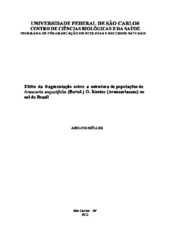Mostrar el registro sencillo del ítem
Efeito da fragmentação sobre a estrutura de populações de Araucaria angustifolia (Bertol.) Kuntze (Araucariaceae) no sul do Brasil
| dc.contributor.author | Müller, Adelcio | |
| dc.date.accessioned | 2016-06-02T19:31:54Z | |
| dc.date.available | 2011-04-11 | |
| dc.date.available | 2016-06-02T19:31:54Z | |
| dc.date.issued | 2011-02-11 | |
| dc.identifier.uri | https://repositorio.ufscar.br/handle/ufscar/2014 | |
| dc.description.abstract | Fragmentation of habitat is the transformation of a continuous natural landscape into habitat patches or fragments, and may result from human settlements, agriculture, resource extraction and/or logging. Besides the influences of habitat loss, populations that remain in these fragments experience conditions similar to those of the surrounding matrix: the process known as "edge influence", one of the determinants which is the type of matrix surrounding the fragment. In the Southern region of Brazil is found the Mixed Ombrophylous Forest, also known as Araucaria Forest, and the species Araucaria angustifolia remains threatened by the use of its wood for domestic and commercial settings, as well conversion of its natural habitat into agropastoral activities and plantations of exotic species. The size distribution of the population carries a wealth of demographic information and often is the most unequivocal attribute available and accessible to a population. Therefore, the aim of this study was to obtain information on the population ecology of Araucaria angustifolia (Bertol.)O. Kuntze (Araucariaceae) on edges facing urban matrix, pasture matrix and agricultural matrix. In each of the five fragments were established 50 plots of 10m x 20m parallel to edge, with 25 deployed immediately at the edge and 25 at a distance of 120 meters from the edge. Within these plots, all individuals of Araucaria angustifolia were evaluated. There was no effect of edge on the structure of populations of Araucaria angustifolia evaluated for most variables, however; however, when we evaluated together matrix and shape of the fragments, we found a direct relationship with the density of individuals. The hypothesis that the population structure of Araucaria differs between the edge and inside regardless of shape, size or type of matrix has not been comproved, possibly because of the large variation in the population parameter between the fragments, independently of shape and matrix. But when these two characteristics were assessed together, they were significantly correlated with the total density of each fragment and its edge and interior. | eng |
| dc.description.sponsorship | Universidade Federal de Sao Carlos | |
| dc.format | application/pdf | por |
| dc.language | por | por |
| dc.publisher | Universidade Federal de São Carlos | por |
| dc.rights | Acesso Aberto | por |
| dc.subject | Ecologia da população | por |
| dc.subject | Influência de borda | por |
| dc.subject | Distribuição de tamanho | por |
| dc.subject | Floresta ombrófila mista | por |
| dc.subject | Solo - uso | por |
| dc.subject | Matriz | por |
| dc.subject | Edge influence | eng |
| dc.subject | Size distribution | eng |
| dc.subject | Mixed ombrophylous forest | eng |
| dc.subject | Matrix | eng |
| dc.title | Efeito da fragmentação sobre a estrutura de populações de Araucaria angustifolia (Bertol.) Kuntze (Araucariaceae) no sul do Brasil | por |
| dc.type | Dissertação | por |
| dc.contributor.advisor1 | Matos, Dalva Maria da Silva | |
| dc.contributor.advisor1Lattes | http://lattes.cnpq.br/4728734263109138 | por |
| dc.description.resumo | A fragmentação de hábitat é a transformação de uma paisagem natural contínua em manchas ou fragmentos de hábitat. Ela pode ser provocado por estabelecimentos humanos, agricultura, extração de recursos e/ou corte de madeira. Além das influências da perda de hábitat, às populações que permanecem nestes fragmentos experimentam condições semelhantes ás da matriz de entorno, a chamada influência de borda , um dos determinantes da influência de borda é o tipo da matriz que circunda o fragmento. Na região Sul do Brasil é encontrada a Floresta Ombrófila Mista, também conhecida como Floresta com Araucária ou Mata de Araucária. A espécie A. angustifolia continua sendo ameaçada devido à utilização da sua madeira para fins domésticos e comerciais, ou por meio da substituição de seu habitat natural por atividades agropastoris e plantações de espécies exóticas. A distribuição de tamanho de população carrega uma riqueza de informação demográfica e frequentemente é o atributo mais inequívoco e acessível disponível para uma população. Diante disso, o objetivo deste trabalho foi o de obter informações sobre a ecologia de populações de Araucaria angustifolia (Bertol.) O. Kuntze (Araucariaceae) em bordas voltadas para matriz urbana, matriz pastagem e matriz agrícola. Em cada um dos cinco fragmentos foram implantadas 50 parcelas de 10m x 20m paralelas a borda, sendo 25 implantadas na margem da borda e 25 a uma distância de 120 metros da borda. Dentro destas parcelas, todos os indivíduos de Araucaria angustifolia foram avaliados. Não foi verificado efeito de borda sobre a estrutura das populações de Araucaria angustifolia avaliadas para a maioria das variáveis analisadas, porém, quando avaliamos conjuntamente a matriz e a forma dos fragmentos encontramos uma relação direta com a densidade de indivíduos. A hipótese de que a estrutura da população de araucaria difere entre a borda e o interior independente da forma, tamanho ou tipo de matriz não foi comprovada, pois, as populações apresentaram grandes variações entre os fragmentos independente destas variáveis descritivas. Porém quando estas variáveis descritivas foram avaliadas conjuntamente (matrizes + forma) se mostraram significativamente correlacionadas com a densidade total de cada fragmento e nos seus ambientes de borda e interior. | por |
| dc.publisher.country | BR | por |
| dc.publisher.initials | UFSCar | por |
| dc.publisher.program | Programa de Pós-Graduação em Ecologia e Recursos Naturais - PPGERN | por |
| dc.subject.cnpq | CIENCIAS BIOLOGICAS::ECOLOGIA | por |
| dc.contributor.authorlattes | http://lattes.cnpq.br/5926860105977898 | por |
